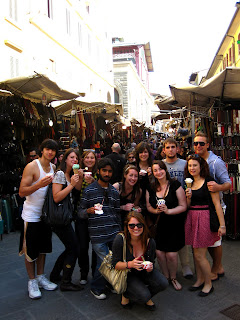

When we arrived in Munich, I was taken aback. All the houses we passed for the first five minutes were brightly colored and none of them were very tall. The streets were immaculately clean without any traces of graffiti whatsoever. For the third largest city in Germany, Munich gave more of a small town, friendly vibe with its residents either riding bikes or taking their dogs for leisurely walks on such a warm Friday evening. Since we were only spending two nights here, our real day of exploring was Saturday morning which began with a walking tour of the city. Let me begin by saying this was the best walking tour I have enjoyed this entire trip. The tour guide was extremely knowledgeable and not only gave us information about the buildings and monuments, but gave us an extensive history of the city itself. Ossie, the tour guide, also gave us a real background about Munich and Bavarian culture. This was the first time I was left with an understanding of the actual citizens of a place instead of just their tourist attractions.
Munich is often referred to as the second capital of Germany and is the capital of the state of Bavaria. Bavaria is the most Catholic state in all of Germany and had sided with the French during the Thirty Years War. Ten years before was actually over, Munich’s duke erected a column with a gold Virgin Mary on top asking her to protect the city from the war, sickness, famine, and the heretics. These four things were symbolized by angels fighting a lion, a basilisk, a dragon, and a serpent. The column is in front of the city town hall and had Ossie pointed out, a monument such as this one says a lot about the people. I also learned that there are some tensions between Berliners and Münchners. However, Münchners are biased like every other people and like to say they live in a much better city than Berlin and that they are proud for maintaining their culture and traditions. They aren’t exactly wrong either; Munich was voted the best city to live both in 2008 and this year and the city enjoys an extremely low crime rate.
In my opinion, Munich is an adorable city that is just filled with history that you would never know unless you looked it up or if you had Ossie as your tour guide. My favorite place in the city is by far, the Englischer Garten. I was lucky enough to squeeze time into going there on both Saturday and early Easter morning. The park is a lot larger than Central Park in NYC; it is over 7km long. Locals can be seen exercising there or just simply sunbathing on one of its several lawns. The coolest area was the surfer’s wave. I kept thinking how much fun it would be to be able to surf on a river in the middle of a city.
All in all, there was just too much of Munich to be explored in such a small amount of time. It is currently on the top of my list of places I must go back to and if I am lucky enough, I will hopefully live in what is the loveliest city ever.

















































